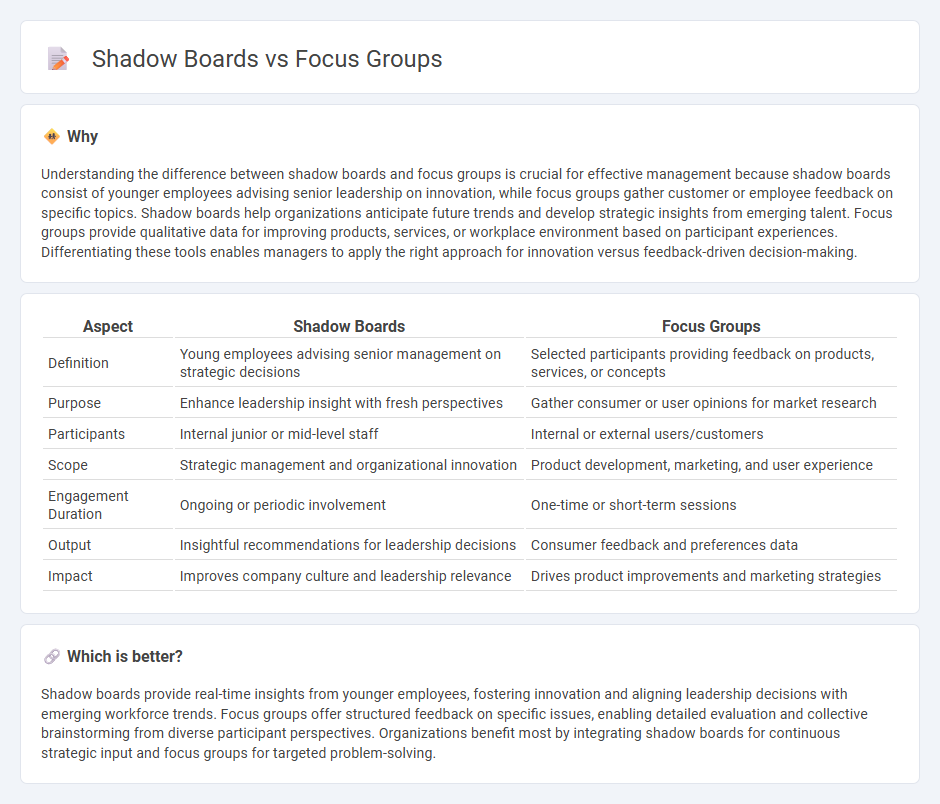
Shadow boards consist of younger employees who advise senior management to bring fresh perspectives and foster innovation in decision-making processes. Focus groups gather diverse participants to provide targeted feedback on specific products, services, or initiatives, enhancing customer insight and strategic planning. Discover how these approaches can optimize organizational management and drive effective leadership.
Why it is important
Understanding the difference between shadow boards and focus groups is crucial for effective management because shadow boards consist of younger employees advising senior leadership on innovation, while focus groups gather customer or employee feedback on specific topics. Shadow boards help organizations anticipate future trends and develop strategic insights from emerging talent. Focus groups provide qualitative data for improving products, services, or workplace environment based on participant experiences. Differentiating these tools enables managers to apply the right approach for innovation versus feedback-driven decision-making.
Comparison Table
| Aspect | Shadow Boards | Focus Groups |
|---|---|---|
| Definition | Young employees advising senior management on strategic decisions | Selected participants providing feedback on products, services, or concepts |
| Purpose | Enhance leadership insight with fresh perspectives | Gather consumer or user opinions for market research |
| Participants | Internal junior or mid-level staff | Internal or external users/customers |
| Scope | Strategic management and organizational innovation | Product development, marketing, and user experience |
| Engagement Duration | Ongoing or periodic involvement | One-time or short-term sessions |
| Output | Insightful recommendations for leadership decisions | Consumer feedback and preferences data |
| Impact | Improves company culture and leadership relevance | Drives product improvements and marketing strategies |
Which is better?
Shadow boards provide real-time insights from younger employees, fostering innovation and aligning leadership decisions with emerging workforce trends. Focus groups offer structured feedback on specific issues, enabling detailed evaluation and collective brainstorming from diverse participant perspectives. Organizations benefit most by integrating shadow boards for continuous strategic input and focus groups for targeted problem-solving.
Connection
Shadow boards and focus groups both serve as strategic tools in management to enhance decision-making and innovation by incorporating diverse perspectives. Shadow boards consist of younger employees or emerging leaders who provide fresh insights on company strategy, while focus groups gather targeted feedback from specific stakeholder segments to refine products or policies. Both mechanisms foster collaborative environments that improve organizational responsiveness and stakeholder engagement.
Key Terms
Participant Selection
Participant selection in focus groups typically targets a diverse mix of individuals representing the broader customer base or demographic segments to gather varied insights and opinions. Shadow boards consist of carefully chosen younger employees or emerging leaders within an organization, selected for their potential to influence strategic decision-making and provide fresh perspectives. Explore further to understand how these tailored selection processes can enhance organizational innovation and impact.
Insights Generation
Focus groups provide qualitative insights by gathering diverse participant perspectives in a controlled setting, enabling deep exploration of specific topics and consumer behaviors. Shadow boards consist of younger employees who collaborate with senior management, generating real-time organizational insights and innovative solutions rooted in frontline experiences. Discover how combining these methods can transform your insights strategy and drive business growth.
Organizational Decision-Making
Focus groups gather diverse employee opinions to influence organizational decision-making by providing qualitative insights that reflect collective experiences and perceptions. Shadow boards, composed of future leaders or younger employees, actively simulate executive decision-making processes to offer innovative perspectives and challenge traditional strategies. Explore how integrating both methods can enhance your organization's adaptive strategy and leadership development.
Source and External Links
Focus Groups - Urban Institute - A focus group is a moderated discussion with individuals who share a common characteristic, used to gain insight into their experiences and perspectives on specific topics, serving as a qualitative data collection tool which complements other methods like interviews or surveys.
What Is a Focus Group? Definition and Guide (2024) - Shopify - Focus groups are typically sessions of 6-10 people led by a trained moderator, designed to generate ideas, test concepts, and explore consumer attitudes interactively, offering rich qualitative insights though with limitations such as small sample size and group influence.
Spotlight on focus groups - PMC - Focus groups are a qualitative research method involving guided group discussions around defined topics, commonly comprising 7-10 participants, used in various fields such as marketing, urban planning, and healthcare to assess attitudes and gather in-depth opinions.
 dowidth.com
dowidth.com